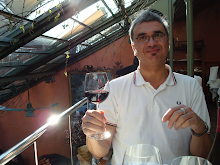This is version of a small wine introduction for tonight. I will present two wines, one white and one red:
Dear friends, I have been asked to select our wines tonight. First of all, you may or may not know that organic or ecological wines is a little bit of a jungle. In reality, there are no completely organic wines. The ones labeled that way are mostly made of organically grown grapes. This means of course that no artificial fertilizers or pesticides have been used, just as in organic agriculture in general. But in the winery, there is no real consensus as to what organic winemaking should entail. The perhaps biggest difficulty lies in the decisions about how you should use sulphur. Sulphur is actually one of the big secrets in winemaking. Without it, most wine would turn quickly into vinegar. Which is a nice product, but more limited than wine with regard to quantities you would want to consume. Anyway, the second category of organic wines are the biodynamically grown. This is even more difficult to define, as all biodynamic growers have their own definitions of what is required. Mostly, the use of artificial fertilizers and pesticides is forbidden, but other than that, the biodynamic grower is concerned about balance in the soil. There are endless tricks, some of them of quite spiritual kind, to make the soil perfect for the grapes. The spiritual content comes partly from the biodynamic guru, mr Steiner of Austria who wrote the antroposophic books that have inspired the biodynamic movement. You need to keep track of the moon, because according to these principles, the moon decides a lot about the right time to do things in the vineyard. The third and currently trendiest category of organic wines are the natural wines. Basically, the same ground rules apply, but you should also do as little as possible in the winery to affect the wine. Even limit your use of sulphur. But also avoid clearing and filtering the wine. There are no real rules here, but a lot of hype. Keep in mind that these wines are quite sensitive, as the lack of sulphur make the difficult to transport, they turn sour and easily become - vinegar. This should not keep you from trying them once in a while. Many sommeliers go bananas currently about these natural wines.
Today's wines are simply organic of the first category. The first wine is made of the king of grapes, riesling. And in no other country do you make better riesling than in Germany. This is not from Mosel or Rheingau, the home of riesling, but from Rheinhessen, a less famous but sometimes nice area for white wine. It has all the signs of a good riesling: crispiness, acidity, fruit and a certain minerality. Carl Reh is the name. The red wine comes from Italy. In Tuscany, the home of chianti, the main grape is sangiovese. This is a sangiovese, which literally means Jupiter's blood from the grower Farnese. It is not as rough as sangiovese sometimes is but instead softish, fruity, made in a popular style that I believe will firt the menu of today. Hope you will all enjoy these wines. Thank you.
Prenumerera på:
Kommentarer till inlägget (Atom)




Inga kommentarer:
Skicka en kommentar